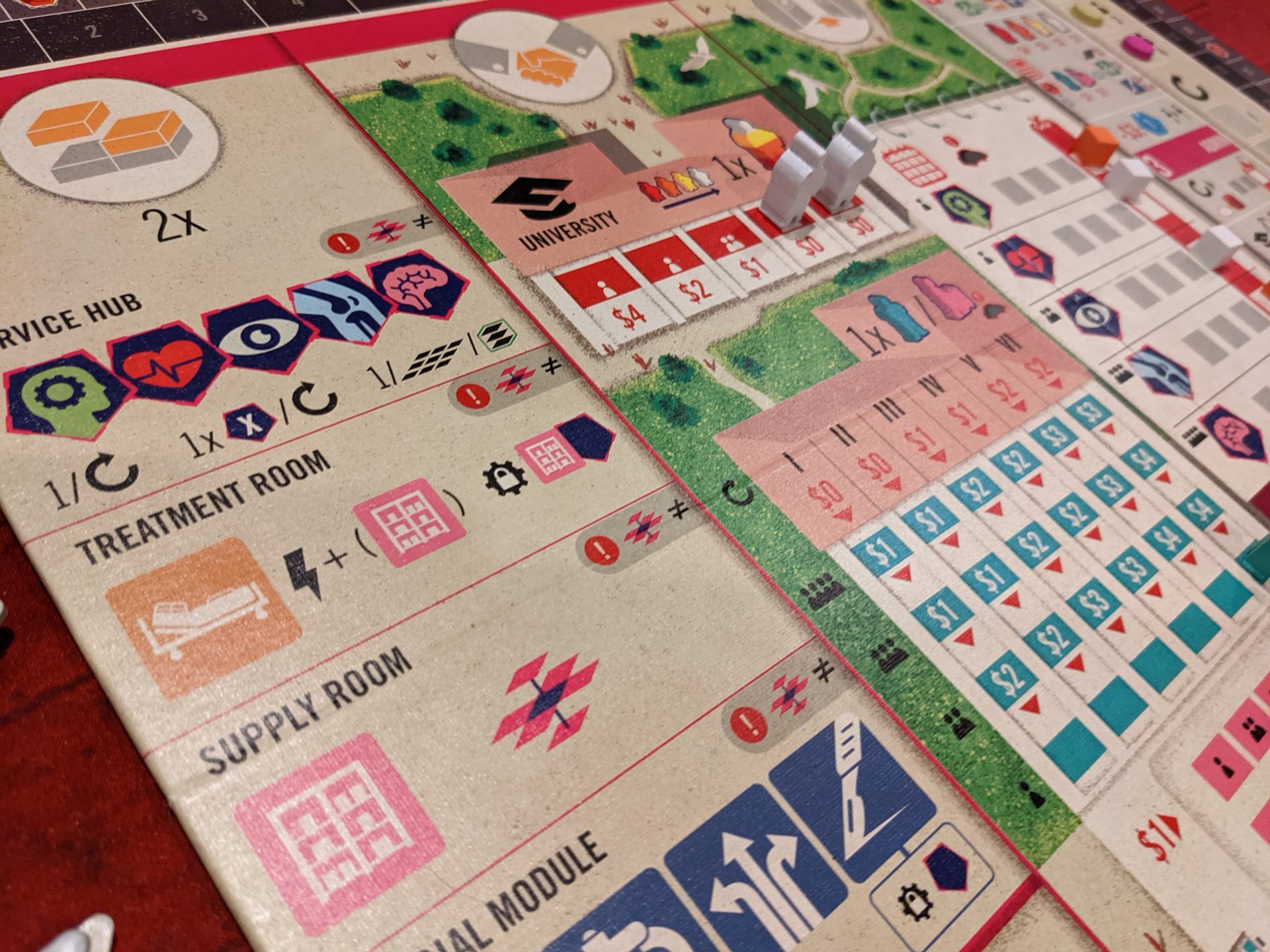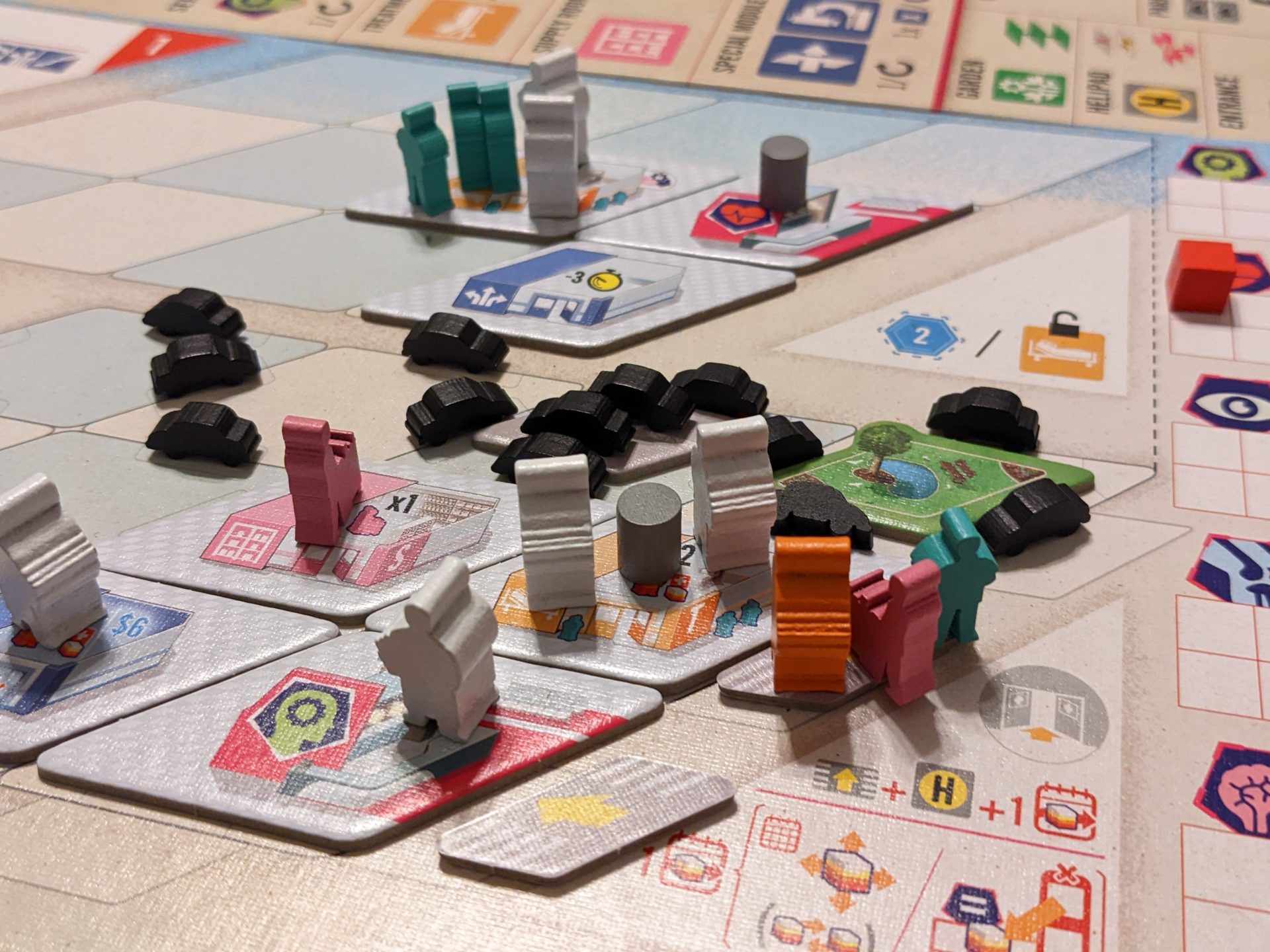Disclosure: Meeple Mountain received a free copy of this product in exchange for an honest, unbiased review. This review is not intended to be an endorsement.
You’re right—Clinic: Deluxe Edition is not a new game. Designer Alban Viard first gave us Clinic in 2014, before the first printing of the deluxe version arrived in 2019.
Following a successful Kickstarter campaign, the game has a new publisher in North America, Capstone Games. And if you’ve been following Capstone for the last 3-4 years, you know that Clinic: Deluxe Edition (or Clinic, for short) is going to lean towards heavier, strategic gameplay.
Clay Ross, the founder of Capstone Games, chatted with me at GAMA Expo this past March about Clinic and I knew Meeple Mountain needed to review it. Clay was kind enough to send the “all in” version of the game. Friends, the all-in version is so massive that I’m only going to review the base game in this article, with a future roundup of expansion content coming later.
(How massive? Try FIFTY individual modules, a campaign book, an expansion based solely on COVID-19, and a solo mode with 10 different end-game goals to beat. This might be the winner for “most content in a single game” this year!)
Capstone has already established itself as the premier medium-to-heavy strategy tabletop publisher based in the US. Ark Nova, Boonlake, Corrosion, Imperial Steam, and a host of other popular titles have cemented this status and Clinic falls right in line with the design philosophy of other recent games.
Across multiple plays with a diverse mix of gamers, I’m happy to say that Clinic has landed well with my groups. Players do not need any expansion content to enjoy the base game; of course, if you DO want expansion content, Clinic has you covered in spades.

The Profitable Business of American Health Care
Clinic puts players in the hospital booties of health care clinic executives. Over the course of 6 rounds, players need to hire the best doctors and build the best facilities to become the most popular clinic in the land by treating patients to earn income. After paying expenses each round, you’ll have to reinvest profits into buying popularity (points) to get ahead of the competition.
Clinic is fairly straightforward in terms of actions and seeing the bigger picture. Each round, players will get a chance to take 3 actions, and the choices are easy to understand.
You can build facilities on your campus, like service hubs to accommodate different types of patients or a lab to ensure you have an on-campus training facility to upskill a doctor every round. New entrances to your buildings, gardens to beautify the property (and earn additional cash), parking lots and even helipads are available to add as well.
You can hire new doctors, nurses and orderlies to service your facilities. You’ll also be able to admit new patients, assuming you have the specialities needed to match the issues facing each potential patient. Just know that all people (hospital staff and patients) share one thing in common:
Everyone parks a single car at your clinic.
That’s right. These people don’t believe in rideshare. They don’t know how to carpool. None of their friends or family can give them a ride to the clinic. Public transportation? No thank you. They balk at the idea of walking to work.
Clinic isn’t exactly the most eco-friendly game ever designed. But that leads to a fun issue: your campus only has so much room for the buildings and all the cars that will pile up if you can’t address the parking concern. I’m surprised how often parking is problematic in Clinic, and I love how many times I have gone to a hospital in real life and left incensed at how terrible the parking situation was.
Art imitates life.
So you know your goals. Build a great facility, hire competent staff, and get patients in the building to milk them for cash by offering great services.
Easy, right? There’s one additional thing I haven’t told you: Clinic also features a spatial puzzle. And that puzzle has a lot of edge case rules around adjacency. This is what elevates the game from medium-weight economic simulation to heavier fare: you’ll need to run a great business that also conforms to rules around where the various pieces of your clinic can be placed.

So, The Treatment Room Needs to Go Where?
I’ve now taught Clinic to 7 other people across 7 total plays (3 solo, 3 3-player games, and one 4-player game), and each time I teach the game, I spend most of my time explaining the rules around adjacency.
Each player is given a player board at the start of play; on the beginner side, you’ll see a 4×3 grid of spaces for tiles to be placed into the first level of your clinic’s campus. After beginning the game with a Service Hub—this determines what kinds of patients can be treated on that floor in your building—a Treatment Room and a Supply Room, you’ll also be given an entrance which is placed next to your Service Hub.
Your player board also shows the layout of a blank level of spaces one floor above anything you build on the ground floor. You also have some other rules; everyone enters your clinic through an entrance tile or a helipad. Everyone—doctors, nurses, patients—walks from place to place, costing you time. Efficiency is vital in Clinic because total time spent is tracked every round for the entire game, and at game end, you will lose a number of points based on the use of time.
Time is money, right?
Even though your actions are straightforward, the puzzle in Clinic is much more dense. I derived plenty of joy from the puzzle and mathing out how many steps I would take in a round to get everyone in position for patient treatment.
How do I get those 2 new patients from the entrance to the third floor to a treatment room where my doctor is waiting? How do I stack modules in my building to take advantage of the smallest footprint in the territory?
More puzzles abound. Doctors come in 4 colors (ranging in skill from white, to yellow, to orange, to red), as do patients; only a matching color pair leads to a successful appointment and a cash payment. But a red doctor could treat, say, an orange patient, as long as that doctor is working with a nurse to make up the difference in severity. A white doctor could treat a red patient, but because of the 3-level difference in severity, that white doctor will need 3 nurses to do so.
Not enough puzzles? We’ve got you. In Clinic, the patients with the worst problems (red) will earn the most money in services ($32). At the end of a round, any patients in your pre-admissions waiting area get a little sicker. Sometimes, you’ll want to bring in patients and intentionally NOT treat them, so that you can make more money on them later.
Yeah. Clinic is that kind of game!

The Interaction
A fair criticism to level against Clinic: for the most part, you are making decisions on your own and you might not experience too much blocking, depending on the situation in each of the 3 action areas on the board.
The lack of interaction mostly holds, until players are fighting over a limited number of patients. Late in the game, that can make all the difference to your bottom line.
Red patients earn the most cash. I recently played a 3-player game of Clinic that came down to a random draw of patients that left a pool of 7 patients on the board: 1 red, 1 yellow, 5 white.
Assuming you have the right staff, the red patient was the only good patient on the board. If all players simultaneously choose the same action, turn order dictates who takes the first action. Another player was able to snake that red patient out from under me because I was second in player order, and he was able to score an extra $32 off of that patient after treating her heart problems.
Love it.
Now, while there are moments like this, for the most part Clinic is not as cutthroat an affair as I was expecting. It’s still tough, but the market conditions usually allow for contingencies to be made in many cases. Each game plays out differently, even without expansion content.
And the way each game of Clinic varies means that the solitaire mode is a fantastic way to learn and continue to play the game. No automa to manage, no silly conditions that would never appear in a full play, and available resources that scale appropriately to having a single player.
In solo mode, the goal is simple: pick one of the 10 requirements listed in the manual (cure all the white patients, use less than 12 total time, earn more than $200, etc.). If you achieve that goal, count your points as normal to measure against a chart of high score levels.

Base Game Mini-Expansions: Zombies?
The base version of Clinic includes 4 mini expansions. 2 of my 7 games included these expansions and here are my thoughts so far:
- Fire extinguishers. Extinguishers serve a similar purpose to what gardens furnish to players: extra income if patients are treated in a room adjacent to an extinguisher. The difference? Walking through a room with an extinguisher costs each meeple one unit of time, and that extra time can add up quickly.
- Blood transfusions. Staff standing along in a service hub can lie down and, for 3 units of time, give blood. This blood can then be carried by nurses to a treatment room. The payoff can be huge: a nurse can treat a patient with this blood (and without the help of a doctor) to make patients a little better, for the treatment income of that color patient. I made a ton of cash on this each time I used it. Along with fire extinguishers, I will add blood transfusions every time I play.
- Workaholic doctors. In the base game of Clinic, doctors cannot treat multiple patients in the same turn. This expansion changes that, by allowing for the hire of a new color of doctor (purple) with the ability to treat 1 red, 2 orange, 3 yellow, or 4 white patients all by herself. She then collapses in exhaustion and leaves the game, making workaholic doctors a one-shot deal. Fun, but I’ve found this is a module that I could take or leave because certain conditions have to line up just right to make workaholics really worth their $8 hiring price.
- Zombies. Seriously, zombies. I’ll never play with zombies in this game again, mainly because this adds nothing to the overall experience. This starts with the rule that creates a zombie in the first place: when any round ends with exactly 2 yellow patients in the same room, they merge and turn into a zombie. Now, I’ll admit that one part of this is funny: those 2 patients had cars, and now those 2 cars are permanently deserted in your parking area. I did this once in the final round just because of the scoring: any zombies that are still in your clinic at the end of the game generate a whopping 9-point bonus, but can wreak havoc on your plans if you create them earlier. Why is this here?

You’re Saying All of This is the Base Game?
While I would have to play Clinic many more times for it to feel old, there is so much content and so many different ways to play the base game that I don’t think it will ever get stale.
I do think Clinic benefits players who have played many more times before, although not in the way that a game such as Food Chain Magnate does. Clinic is absolutely the kind of game you want to find a group of 2-3 friends to play with regularly; the rewards for multiple plays appear to be stupendous.
Once you have the gameplay concepts and the iconography down, I could see 4-player games of Clinic buzzing by in 90 minutes pretty consistently. (I would be remiss if I didn’t mention that the artwork by Ian O’Toole and the graphic design by Todd Sanders are both excellent).
Clinic is highly recommended, assuming you can invest in multiple plays. The gameplay is fun and the late-game decisions can be really, really satisfying in their level of crunch. I’ll admit that I love economic games where every choice counts but money is not super tight.
Successive plays have made the experience much more rewarding. Even though Clinic is a few years old, it’s exciting that Capstone has helped bring this game back to the masses!












Add Comment